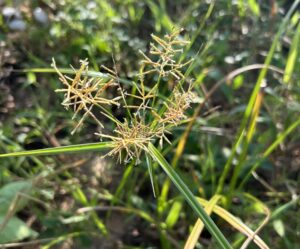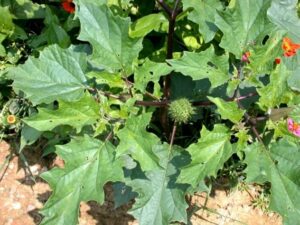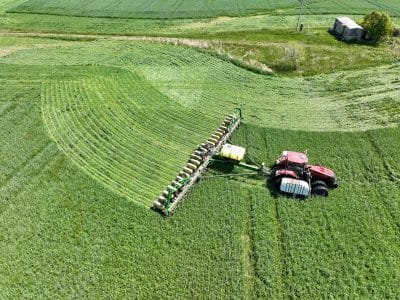Urochloa platyphylla
Broadleaf signalgrass is a summer annual grass species characterized by its broad yet short leaves. This grass species is one of the top ten prevalent and problematic weeds in many states, including Alabama, Arkansas, Florida, Kentucky, Louisiana, Mississippi, North Carolina, South Carolina, Tennessee, and Texas. This native plant can be found in the southeastern and south-central United States, as well as in regions of the West Indies and South America.

Identifying Features
Broadleaf signalgrass, a prostrate summer annual weed, commonly invades agricultural fields, ditches, disturbed areas, and roadsides. During germination, the cotyledon (the first leaf blade) is straight and grows parallel to the ground. As this weed matures, it adopts a decumbent growth pattern, which means branching stems extend from the base and grow along the ground, sending shoots upward from their tips. Mature plants have a well-developed fibrous root system, with reproductive stems capable of attaining lengths between 27 to 35 inches.

Broadleaf signalgrass leaves are rolled as they emerge. Once unfurled, they have smooth leaf blades with a keeled leaf tip and often a rippled (or crinkled) leaf margin. The leaf surfaces are hairless which differentiates it from Texas panicum (Fig 2). The collar region lacks auricles but has a short membranous ligule with hairs on the edges and this distinguishes signalgrass from large and smooth crabgrass. Fully expanded leaves have a visible midvein and a broad whitish collar region (collar region is where the leaf blade meets the stem). The leaf sheaths are open and compressed, and are usually smooth, although a small tuft of hairs may occasionally be found at the sheath’s base.

Seed Production
The prolific seed production of broadleaf signalgrass significantly contributes to its aggressive spread within disturbed sites. Its seeds are readily disperse along roadsides and agricultural land. The seeds, measuring approximately 0.2 inch in length, exhibit a finely wrinkled seed coat texture (Fig 3). The weed can infest diverse environments, such as moist ditch habitats and uneven soil surfaces. It can also spread via farm equipment and irrigation ditches. Between June and October, mature broadleaf signalgrass stands can generate about 30,000 seeds per square meter, capable of not only replenishing the soil seedbank but also producing dense infestations during subsequent seasons if left uncontrolled.


Herbicide Resistance
None reported.
Unique Feature
Broadleaf signalgrass has adaptive seed behaviors that help it survive herbicide applications. Studies have shown that viable seeds can remain attached to crop residue, detaching and falling only when the preemergence herbicide’s effectiveness has declined. This delayed survival mechanism allows broadleaf signalgrass to evade the residual effects of herbicides that would otherwise control young seedlings.
Integrated Weed Management Options
Implementing an Integrated Weed Management (IWM) strategy is the most effective approach for the sustained suppression of this prolific summer annual weed.
Recent research trials have demonstrated that incorporating crop rotation, strategic herbicide application, and other agronomic practices can result in a significant reduction in broadleaf signalgrass emergence compared to untreated plots. The key to controlling annual weeds is aligning control measures with vulnerable life stages. Several practices have shown particular effectiveness in controlling broadleaf signalgrass:
Cover Crops
Cover crops present a promising strategy for managing broadleaf signalgrass. By cultivating a competitive cover crop between cash crop rotations, growers can disrupt broadleaf signalgrass development and suppress its growth. Cover crops compete for growth resources, including light, water, and nutrients, preventing the germination and establishment of broadleaf signalgrass. Some cover crop species, like cereal rye, may be able to suppress weeds and hinder their growth and seed germination. While specific research on using cover crops for broadleaf signalgrass control is emerging, studies on their effectiveness against other invasive weeds offer promising results.
Harvest Weed Seed Control (HWSC)
HWSC may be a promising strategy for controlling broadleaf signalgrass. HWSC involves collecting and crushing viable weed seeds during crop harvest and eliminating weed seeds return to the soil. While seed retention studies still need to be done, previous studies have shown that broadleaf signalgrass can retain its seeds on overwintering residue in no-till fields. This finding suggests that seeds of broadleaf signalgrass would be retained on the plant at harvest time, and therefore would be susceptible at harvest to HWSC.
Crop Rotation
In general, previous research reports have shown that crop rotation and intercropping techniques lower the population, weed density, and biomass of most weeds. Specific to broadleaf signalgrass, varying crop selection, and planting dates can disrupt the predictable growth environment upon which this weed relies, impeding its establishment and reproduction. Numerous processes contribute to broadleaf signalgrass suppression through crop rotation; alternating between broadleaf and grass crops can disrupt the ability of broadleaf signalgrass to compete.
Herbicide Control Options
Corn
To burndown signalgrass, you can use herbicides like glufosinate (Liberty), glyphosate, or paraquat (Gramoxone). Preemergence application can include herbicides like pyroxasulfone (Zidua or Anthem products), S-metolachlor (Bicep II Magnum, Dual II Magnum, etc.), and acetochlor (Degree Xtra, Harness Xtra, Warrant, etc.). Applying glyphosate at postemergence can also be used to control signalgrass.
Soybean
Herbicides listed above in corn can be used as burndown. Preemergence herbicides that can be applied to control signalgrass include pyroxasulfone (Zidua or Anthem products), and S-metolachlor (Dual Magnum, etc.). Herbicides that can be applied postemergence are glyphosate, fluazifop (Fusion DX), clethodim (Select, Select Max), sethoxydim (Poast), and quizalofop (Assure II, Targa).
Cotton
Preemergence herbicides for control of broadleaf signalgrass include pendimethalin (Prowl) and acetochlor (Warrant), while postemergence options include glyphosate, fluazifop (Fusilade DX), clethodim (Select, Select Max), sethoxydim (Poast), and quizalofop (Assure II, Targa).
Since broadleaf signalgrass readily grows along roadsides and field margins, keeping these areas mowed in the late summer and early fall to limit the spread of seeds into adjacent fields is an important prevention strategy to use.
Resources
WSSA Composite List of Weeds.
Eppo Global Database. https://gd.eppo.int/taxon/BRAPP
Citations
Alford JL, Hayes RM, Rhodes GN, Steckel LE, Mueller TC (2005) Broadleaf signalgrass (Brachiaria platyphylla) interference in corn. Weed Science 53:97-100.
Chamblee RW, Thompson L, Coble HD (1982) Interference of broadleaf signalgrass (Brachiaria platyphylla) in peanuts (Arachis hypogaea). Weed Science 30:45-49.
Dowler CC, (1992) Weed survey-southern states. In Proc. South. Weed Science Society 45:392-407.
Liebman M, Dyck E, (1993) Crop rotation and intercropping strategies for weed management. Ecological Applications 3:92-122.
Schwartz-Lazaro LM, Korres NE, Bararpour T, Bagavathiannan M, Green J, Norsworthy JK (2022) Population dynamics of naturally occurring weed flora in response to crop rotation and HPPD-inhibiting herbicide-based treatments. Weed Technology 36:426-435.
Van Wychen L (2022) 2022 Survey of the most common and troublesome weeds in broadleaf crops, fruits & vegetables in the United States and Canada. Weed Science Society of America National Weed Survey Dataset. Available: https://wssa.net/wp-content/uploads/2022-Weed-Survey-Broadleaf-crops.xlsx
Webster TM, (2000) Weed survey—southern states. In Proc. South. Weed Science Society 53:247-274.
Author
Oluwaseun Ola, Southern Illinois University
Editors
Karla Gage, Southern Illinois University
Mark VanGessel, University of Delaware
Emily Unglesbee, GROW
Claudio Rubione, GROW

































































































